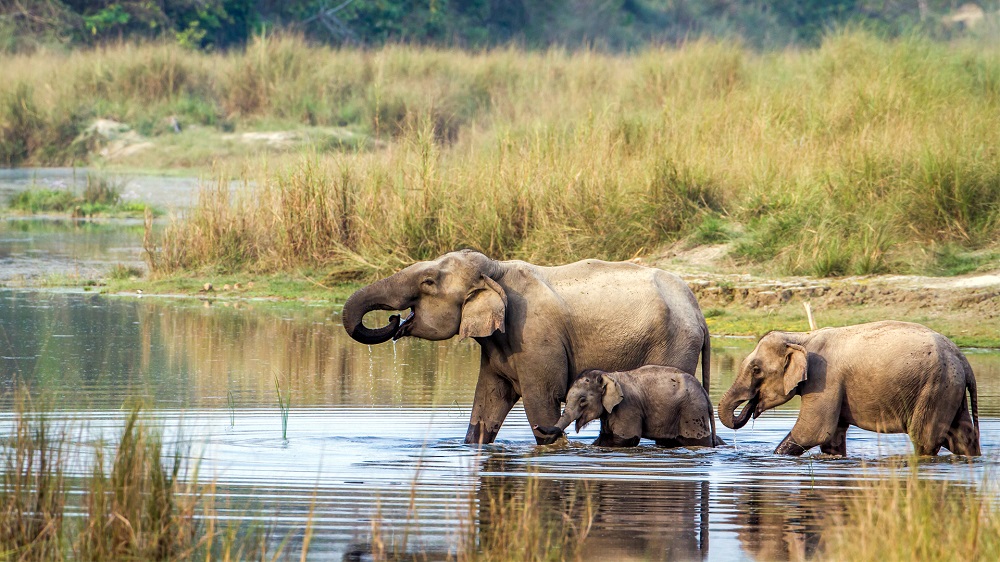About Chitwan National Park
Chitwan National Park is a renowned protected area located in the Terai region of southern Nepal. It is recognized as a UNESCO World Heritage site and offers a diverse range of flora and fauna. Here's everything you need to know about Chitwan National Park:
1. Location and Geography:
Chitwan National Park is located in the lowland Terai region of Nepal, bordering India. It is situated at an altitude ranging from 100 meters (328 feet) to 815 meters (2,674 feet) above sea level. The park spans across the districts of Chitwan, Nawalparasi, Parsa, and Makwanpur in southern Nepal. The park's landscape is characterized by flat plains, riverine forests, wetlands, and grasslands.
2. Establishment and Conservation:
Chitwan National Park was established in 1973, becoming the first national park in Nepal. It was initially created as a royal hunting reserve to protect wildlife, particularly the endangered one-horned rhinoceros. In 1984, it was designated as a UNESCO World Heritage site, recognizing its unique natural value and conservation efforts. The park is managed by the Department of National Parks and Wildlife Conservation of Nepal.
3. Biodiversity:
Chitwan National Park is renowned for its rich biodiversity and is home to a wide range of plant and animal species. The park supports over 700 species of wildlife, including the iconic Bengal tiger, one-horned rhinoceros, Asian elephant, leopard, sloth bear, wild boar, and various species of deer. The park is also a haven for birdwatchers, with a diverse avian population that includes peafowl, herons, kingfishers, storks, and endangered species such as the Bengal florican and great hornbill.
4. Vegetation:
Chitwan National Park is characterized by diverse ecosystems and vegetation types. The park consists of riverine forests dominated by species like sal (Shorea robusta), silk cotton (Bombax ceiba), and Indian rosewood (Dalbergia sissoo). It also encompasses grasslands, which provide vital habitat for wildlife and support a range of grass species such as elephant grass (Saccharum ravennae). The park's vegetation provides food, shelter, and breeding grounds for its diverse wildlife.
5. Wildlife Activities:
Chitwan National Park offers a variety of activities for visitors to explore its wildlife. Elephant safaris are a popular way to venture deep into the park and observe wildlife from a close vantage point. During these safaris, visitors can spot one-horned rhinoceros, deer, monkeys, and various bird species. Jeep safaris are another option for exploring the park, allowing visitors to cover more ground and search for elusive wildlife such as tigers and leopards. Guided nature walks, birdwatching tours, and boat rides along the Rapti River are also available.
6. Tharu Culture and Villages:
The indigenous Tharu community has a long history of inhabiting the Chitwan region. The park provides an opportunity to learn about the Tharu culture, traditions, and lifestyle. Visitors can visit Tharu villages and experience their unique dances, music, and art forms. Staying in traditional Tharu homestays offers a chance to immerse oneself in the local culture and hospitality, allowing for a deeper understanding of the Tharu way of life.
7. Conservation Efforts:
Chitwan National Park is actively involved in conservation efforts to protect its biodiversity and ecosystems. Anti-poaching patrols are conducted to combat illegal wildlife trade and protect endangered species such as the rhinoceros and tiger. The park focuses on habitat management, community-based conservation initiatives, and wildlife research. It collaborates with local communities to promote sustainable livelihoods and raise awareness about the importance of conservation.
8. Visitor Information:
To visit Chitwan National Park, tourists are required to obtain an entry permit at the park's entrance gate. The park offers a range of accommodation options, including luxury resorts, jungle lodges, and budget guesthouses, catering to various preferences and budgets. It is advisable to hire a local guide for wildlife activities to ensure safety, enhance the experience, and learn more about the park's flora and fauna.




.jpg)



